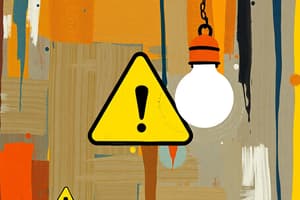Podcast
Questions and Answers
OSHA's electrical standards are based on:
OSHA's electrical standards are based on:
- Suggestions submitted by industry and ad hoc committees
- ANSI standards
- NIOSH regulations
- The NEC (correct)
What are the four main types of electrical injuries?
What are the four main types of electrical injuries?
- Fractures, burns, neurological circuit disruption, heart attack
- Falls, concussions, arrhythmia, burns
- Electrocution, electric shock, burns, indirect (e.g., a fall from a ladder) (correct)
- Electrocution, paralysis, loss of bone density, emotional trauma
Electricity travels in closed circuits, and its normal route is through a conductor. Electric shock occurs when:
Electricity travels in closed circuits, and its normal route is through a conductor. Electric shock occurs when:
- The circuit becomes part of the conductor
- The body becomes part of the circuit (correct)
- Static electricity gathers outside the circuit
- Electricity jumps its normal path and strikes a person
A shock's severity depends on:
A shock's severity depends on:
Electrical burns are the most serious of the three major types of burns, and most often occur:
Electrical burns are the most serious of the three major types of burns, and most often occur:
Hot wires, ungrounded wires that can cause a shock if you touch them, are usually:
Hot wires, ungrounded wires that can cause a shock if you touch them, are usually:
More than 50 percent of electrocutions are caused by a worker coming in direct contact with:
More than 50 percent of electrocutions are caused by a worker coming in direct contact with:
The OSHA standard requires flexible cords to be rated for:
The OSHA standard requires flexible cords to be rated for:
What is the most frequent violation of OSHA electrical standards?
What is the most frequent violation of OSHA electrical standards?
The three elements of a basic program for electrical safety are:
The three elements of a basic program for electrical safety are:
All portable electric tools that are damaged shall be:
All portable electric tools that are damaged shall be:
If you have a three-prong plug and a two-hole receptacle, it is acceptable to:
If you have a three-prong plug and a two-hole receptacle, it is acceptable to:
All hazards involved in the use of power tools can be prevented by following five basic safety rules: Keep all tools in good condition with regular maintenance; examine each tool for damage before use; operate according to the manufacturer's instructions; provide and use the proper protective equipment; and:
All hazards involved in the use of power tools can be prevented by following five basic safety rules: Keep all tools in good condition with regular maintenance; examine each tool for damage before use; operate according to the manufacturer's instructions; provide and use the proper protective equipment; and:
Live parts of electric equipment operating at 50 volts or more must be:
Live parts of electric equipment operating at 50 volts or more must be:
While any employee is exposed to contact with parts of electric equipment or circuits that have been deenergized, the circuits energizing the parts shall be:
While any employee is exposed to contact with parts of electric equipment or circuits that have been deenergized, the circuits energizing the parts shall be:
AEGCPs are implemented on construction sites to oversee:
AEGCPs are implemented on construction sites to oversee:
A ground-fault circuit interrupter (GFCI) protects workers from shock by:
A ground-fault circuit interrupter (GFCI) protects workers from shock by:
The majority of today's power line accidents occur because:
The majority of today's power line accidents occur because:
Flashcards are hidden until you start studying
Study Notes
OSHA Electrical Safety Standards
- OSHA's electrical standards are primarily based on the National Electrical Code (NEC).
- ANSI standards and NIOSH regulations play a lesser role in guiding these standards.
Types of Electrical Injuries
- Main electrical injuries include electrocution, electric shock, burns, and indirect injuries (e.g., falls).
Mechanism of Electric Shock
- Electric shock occurs when the body becomes part of the electrical circuit.
Severity of Electric Shock
- Shock severity is influenced by exposure time, current amount, frequency, and current path.
Electrical Burns
- The most serious burns from electricity typically occur on the hands due to direct contact.
Identification of Hot Wires
- Hot wires, which can cause shock, are usually colored black or red.
Causes of Electrocution
- Over 50% of electrocutions result from direct contact with energized power lines.
Flexible Cord Requirements
- Flexible cords must be rated for hard or extra-hard usage as per OSHA standards.
Common Electrical Violations
- The most frequent OSHA electrical standard violation is improper grounding of circuits and equipment.
Electrical Safety Program Elements
- A basic electrical safety program involves recognizing, evaluating, and controlling hazards.
Handling Damaged Tools
- Damaged portable electric tools should be removed from use and tagged "Do Not Use."
Plug and Receptacle Use
- For a three-prong plug with a two-hole receptacle, an adapter with a grounded wire is acceptable.
Power Tool Safety Rules
- Follow five basic rules including keeping tools in good condition and using the right tool for the job.
Protection from Electric Contact
- Live parts over 50 volts must be guarded against accidental contact to ensure worker safety.
Lockout/Tagout Procedures
- Circuits that can be accessed must be locked out or tagged out to prevent accidental energization.
AEGCP Implementation
- AEGCPs oversee power connections, cord sets, and receptacles that are not part of a building structure.
Ground-Fault Circuit Interrupter (GFCI)
- GFCIs protect from shock by monitoring current input and output, shutting down if an imbalance is detected.
Power Line Accident Causes
- Most power line accidents stem from failures to maintain proper work distances.
Studying That Suits You
Use AI to generate personalized quizzes and flashcards to suit your learning preferences.




